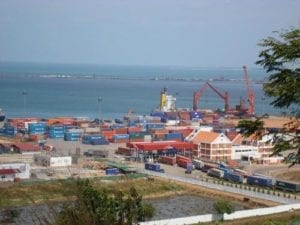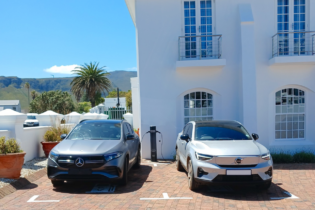A study on the transport and infrastructure in northern Mozambique was recently undertaken and is soon to be published by the South Africa Institute of International Affairs (SAIIA). Simon Foulds spoke to Dr Sören Scholvin about the study he conducted. Here is an extract from SAIIA’s Occasional Paper that is due to be published.
During the past few years, central and northern Mozambique has become a true El Dorado. The Brazilian mining giant Vale and its Australian counterpart Rio Tinto seek to export 44 million tonnes of coal a year from Tete Province. An Australian miner, Global Metals, plans to construct a heavy rare-earth mining and processing plant east of Tete. In Nacala, the Irish company Kenmare Resources wants to mine 612 000 tonnes of ilmenite, 24 000 tonnes of zircon and 12 500 tonnes of rutile a year. Near the Tanzanian border, other minerals and natural gas are to be mined in tremendous quantities. Insufficient investment Yet, transport infrastructure remains insufficient for major investments. Mozambique stretches 2 000 km from north to south. Only one transport axis, the EN1, connects the capital Maputo to the central and northernprovinces. There are no railway lines from Maputo to towns further northwards. Whilst the 545 km from Mozambique’s capital to Johannesburg can be covered in five to six hours, non-stop road transport from Maputo to Pemba in the very north theoretically takes about 26 hours. By public transport, meaning non-scheduled mini-buses, the trip takes two-and-a-half days. Some years ago, it would have taken six days at best with poor chances of reaching Pemba at all. In addition to distance, the Zambezi River, which is up to eight kilometres wide downstream of CahoraBassa, poses a tremendous obstacle to movement. Only three bridges cross it. Nature is not favourable for maritime transport either. Mozambique’s coastal waters are shallow, andcoral reefsand mangroves virtually cut them off from the open sea. Swamps abut the shores. Nacala is the only natural deep-sea port. The harbour of Beira, the second-busiest of the country behind Maputo, lies at the end of a 40-kilometre access channel that has to be drained frequently. Fully loaded large vessels cannot reach Beira at low tide because they would run aground. Present history Since the end of Mozambique’s civil war, during which apartheid South Africa and its proxy, the Resistência Nacional Moçambicana (Mozambican National Resistance),sabotaged transport infrastructure,much progress has been made. Today, 83% of the main road network is in good or fair condition according to World Bank studies, meaning that no immediate maintenance is needed there. In 1990, the according share was 30%. Having reached the ports of Beira, Nacala, Pemba or Quelimane, one still faces serious problems to export goods though. Until recently, Beira had a total throughput of 2.4 million tonnes a year, Nacala was 740 000 tonnes a year, Pemba 80 000 tonnes a year and Quelimane 60 000 to 150 000tonnes a year. South Africa’s largest ports, Durban and Richards Bay, reach an annual volume of 45 million and 80 million tonnes respectively. Mozambique’s harbours often lack even basic storage facilities. Those run by Mozambican state authorities suffer from serious management problems. In Beira, it takes four times as long as in Durban to get imported goods ready for transport by rail or road. Given this mismatch of enormous economic opportunities and poor transport infrastructure, overseas companies have started paying and carrying out construction work that they consider essential for their operations. Infrastructure The present upgrading of road infrastructure is concentrated on the area around Pemba in Cabo Delgado Province, where oil and natural gas companies seek to link their future facilities with the global markets, and neighbouring Nampula Province. Large overseas companies usually plan and pay for according projects in order to rehabilitate road sections of up to 400 km. Overseas state agencies play a key role, in particular the Japan International Cooperation Agency, the South Korean Exim Bank and the Millennium Challenge Corporation from the US. The Mozambican government, which has identified transport infrastructure as fundament for economic development, has launched various public-private partnerships and grants concessions to consortia that build or rehabilitate roads. Major players on the global construction market have been contracted for these projects. Portuguese companies, in particular Conduril, MotaEngil and Zagope, are predominant. Chinese enterprises – China Communications Construction Company, China Henan International Cooperation Group and Weihai International Economic & Technical Cooperative –have been granted most but not the largest contracts. Construction companies from other countries are much less involved, with Cooperativa Muratori & Cementisti (CMC) di Ravenna from Italy being an important exception. Rail and port Upgrading the railway system is an even more pressing need than road infrastructure because exporting the tremendous resources from central Mozambique depends upon transport by rail. By upgrading the railway system, costs of transport from the coal fields in Tete Province to the port of Beira can, presumably, be reduced from US$55 (R559) to US$25 a tonne.So far, only the rail project driven by Vale is actually being carried out. When completed, the Sena Linafrom the mining town Moatize to Beira will be able to transport 12 milliontonnes instead of six million tonnes of coal a year. Beira’s new coal terminal, opened in June 2012, was constructed in partnership with Rio Tinto and Vale. It can handle up to six million tonnes of coal a year. In the long run, the capacity for shipping coal at Beira is scheduled to increase to 20 million tonnes a year. Given that the envisaged capacity will still be insufficient for Vale’s envisaged exports, the Brazilian giant also sponsors the rehabilitation of a railway line from Moatize to Nacala. Presently, the port of Nacala handles only 200 ships annually. If upgraded sufficiently, an annual 40 to 60 million tonnes of coal may be shipped via Nacala.Several other overseas companies have proposed comparable projects: Rio Tinto favours a railway line from Moatize to the Quelimane area, where a new deep-sea port will be built if the project is realised. Twenty million tonnes of coal will pass through the expanded port of Quelimane – or, alternatively, through a totally new one in nearby Macuze – every year.Pemba
Further northwards, Pemba is another potential deep-sea port. It may ease the export of minerals, especially graphite from the nearby Balama ore body, which contains more graphite than all other ore bodies around the world together. The development of the very north of Mozambique, meaning the region whose potential gateway is Pemba, is somewhat different from the dynamics triggered exclusively by coal in Tete Province, Beira and Nacala. In addition to the just-mentioned graphite resources, natural gas plays a key role there. The Rovuma Basin is expected to contain 850 billion cubic metres of natural gas. Natural gas obviously requires a different transport infrastructure than solid minerals. The American company Anadarko Petroleum and Eni from Italy seek to set up facilities for liquefying natural gas in Cabo Delgado Province. Liquefied natural gas would be exported by ship, possibly to the booming Asian economies and, in lesser quantities, to South Africa. Alternatively, natural gas may be exported by pipeline to the neighbouring countries or used domestically for power generation in order to cover the demand of energy-intensive users such as the mines in Tete Province. These may also supply the inputs for coal-to-liquids conversion in Pemba. A petrochemical industry, including fertiliser plants, can be developed, too. Aluminium smelting is another option. Beira and Nacala Beyond the national scale, the ports of Beira and Nacala are what one may call the natural gateways for Mozambique’s landlocked neighbours, Malawi and Zimbabwe, and maybe even Zambia and the Democratic Republic of the Congo’s (DRC) Katanga Province. These would greatly benefit from upgraded transport corridors through Mozambique, as these could significantly ease cost barriers to overseas trade. If there were a functioning railway line from Malawi to Beira, transport costs for Malawi’s sugar exports would decline from presently US$75 a tonne to US$25 a tonne. The port of Beira presently handles 50 lorries a day to Zimbabwe, more than 100 a day to Malawi and five a week to Zambia. Trans-shipments destined for Botswana and the DRC are increasing. Experts of the SADC expect the demand for transit traffic through central and northern Mozambique to rise to 6.1 million TEUs in 2030 and to 12.0 million TEUs in 2040. An envisaged oil terminal in Beira with a capacity of 65 000 might not only supply the domestic market but also the DRC, Malawi, Zambia and Zimbabwe. Serious shortcomings However, there are serious shortcomings of the regional embeddedness of transport infrastructure projects carried out in central and northern Mozambique. Executives of overseas companies and international donors argue that SADC plays a marginal role in these projects because of a lack of consent amongst its member states. The simple reason for the inefficiency of SADC on transregional corridors is probably that the ports in East and Southern Africa are competing with each other. A successful development of the Beira and Nacala corridors would, most likely, divert trade that presently goes through Durban and Richards Bay, costing South African jobs – a scenario that Rob Davies, Minister of Trade and Industry in South Africa, has already denounced as incompatible with government policy. Friction among states thus hampers the upgrading of transport infrastructure. Most prominently, Malawi’s inland port at Nsanje has not been used since it was formally opened in October 2011 because Mozambique insists on a feasibility study on the navigability of the rivers Shire and Zambezi. The author Dr des SörenScholvin is a research fellow at the Institute of Economic and Cultural Geography at the Leibniz-Universität Hannover and an associated researcher at the GIGA German Institute of Global and Area Studies. His research interests are the energy policy of emerging powers, regional economic integration in South America and sub-Saharan Africa, and transport infrastructure in sub-Saharan Africa. SAIIA (South African Institute of International Affairs) SAIIA has a long and proud record as South Africa’s premier research institute on international issues.It is an independent, non-government think-tank whose purpose is to encourage wider and more informed awareness of the importance of international affairs.It is both a centre for research excellence and a home for stimulating public debate. The SAIIA is situated at Jan Smuts House on the campus of the University of the Witwatersrand.







